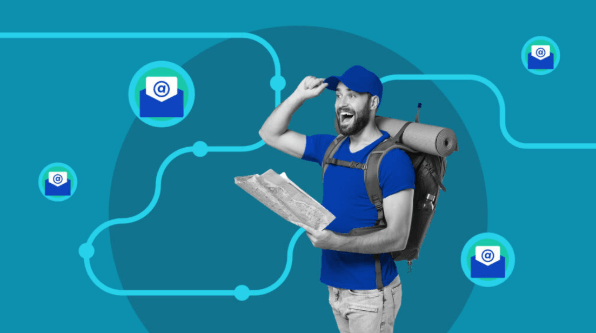How the Email Customer Journey Impacts Conversions

Email marketing remains a cornerstone of digital strategy, offering a direct and cost-effective channel to drive conversions. The email customer journey—encompassing every email interaction from initial awareness to post-purchase engagement—plays a pivotal role in guiding prospects toward purchase decisions and fostering loyalty. By strategically aligning emails with the stages of the customer journey (awareness, consideration, purchase, and retention), businesses can optimize campaigns to maximize conversions in both B2B and B2C contexts. This article explores how the email customer journey influences conversion rates, providing actionable insights to craft targeted, impactful campaigns that deliver measurable results.
Setting the Stage for Conversion Success
The email customer journey begins with a clear understanding of its role in driving conversions across its four key stages: awareness, consideration, purchase, and retention. Each stage presents unique opportunities to engage recipients and move them closer to a conversion, whether that’s a product purchase, a service contract, or a repeat transaction.
In the awareness stage, emails introduce the brand to new prospects, sparking interest through welcome series or promotional offers. A B2C retailer might send a discount code to new subscribers, encouraging a first purchase, while a B2B vendor could share industry insights to attract decision-makers. The consideration stage focuses on nurturing leads with informative content, such as product guides or case studies, to build trust. Purchase-stage emails drive action with clear calls-to-action, like cart abandonment reminders or contract prompts. Retention emails, such as loyalty offers, encourage repeat conversions.
By aligning email strategies with these stages, businesses create a cohesive journey that guides recipients toward conversion, setting the foundation for impactful campaigns.
Leveraging Data to Drive Targeted Engagement
Data is the backbone of an effective email customer journey, providing insights into recipient behavior that directly impact conversions. Quantitative metrics, such as open rates, click-through rates, and conversion rates from email platforms, reveal how recipients interact with campaigns. For example, a B2C brand might notice high open rates for promotional emails but low clicks, indicating a need for stronger calls-to-action. In B2B, a vendor could see robust engagement with technical webinars, suggesting demand for educational content.
Qualitative data, gathered through surveys or feedback forms, uncovers motivations and pain points. A B2C shopper might value personalized recommendations, while a B2B buyer could prioritize detailed ROI analyses. Social listening tools can further capture sentiment on platforms like LinkedIn, showing how recipients perceive email campaigns.
By synthesizing these insights, marketers can craft emails that resonate at each stage, driving conversions. For instance, a B2C retailer might use purchase data to send targeted product offers, while a B2B vendor tailors emails to address specific industry challenges. This data-driven approach ensures emails are relevant, increasing the likelihood of conversion.
Crafting Emails for Each Journey Stage
The email customer journey directly impacts conversions by delivering the right message at the right time. Each stage requires tailored emails that align with recipient needs and behaviors, guiding them toward action.
In the awareness stage, emails must capture attention and encourage initial engagement. A B2C brand might send a welcome email with a limited-time discount, prompting a first purchase, while a B2B vendor could share a thought leadership newsletter to establish credibility. During consideration, emails provide value through content like product demos or customer success stories. For example, a B2C retailer might send a comparison guide to help shoppers choose, while a B2B vendor offers a case study to address decision-maker concerns.
Purchase-stage emails are critical for sealing conversions. A B2C cart abandonment email with a clear “Complete Your Purchase” button can recover lost sales, while a B2B follow-up email with a streamlined proposal can close a deal. Retention emails, such as loyalty discounts or onboarding tips, encourage repeat conversions by maintaining engagement post-purchase.
By crafting stage-specific emails, marketers ensure each touchpoint moves recipients closer to conversion, maximizing campaign effectiveness.
Personalization as a Conversion Driver
Personalization is a powerful lever for boosting conversions, as recipients expect emails tailored to their preferences. AI-driven tools and CRM data enable marketers to customize content, increasing open rates and click-throughs that lead to purchases.
For instance, a B2C retailer might use browsing data to send personalized product recommendations, such as suggesting running shoes to a customer who viewed fitness gear. In B2B, a vendor could leverage CRM insights to send a tailored case study to a prospect who attended a webinar, addressing their specific pain points. Dynamic content, like inserting a recipient’s name or company, enhances relevance, making emails feel personal and actionable.
Timing is also critical. Marketing automation platforms can trigger emails based on behavior, such as sending a cart abandonment email within hours or a follow-up after a demo request. However, personalization must respect privacy. Compliance with regulations like GDPR ensures transparent data use, building trust that encourages conversions. By aligning emails with recipient needs, personalization drives engagement and converts interest into action.
Testing Emails to Optimize Conversion Rates
Testing is essential for refining the email customer journey and boosting conversions. A/B testing allows marketers to experiment with elements like subject lines, visuals, or calls-to-action to identify what drives the best results.
For example, a B2C brand might test two subject lines for a promotional email, finding that a question-based approach increases opens by 20%. In B2B, a vendor could test email layouts, discovering that a concise design with a prominent call-to-action boosts demo requests. AI tools can analyze thousands of variations, providing real-time insights to optimize performance.
Behavioral triggers enhance testing. A B2C retailer might test different timings for cart abandonment emails, identifying the optimal window for re-engagement. In B2B, testing follow-up email frequency can reveal what drives conversions without overwhelming recipients. Regular analysis of conversion metrics ensures campaigns evolve with recipient behavior, maximizing their impact on the customer journey.
Integrating Email with Broader Marketing Efforts
Email’s impact on conversions is amplified when integrated with other marketing channels, creating a cohesive customer journey. A B2C customer receiving a promotional email should encounter consistent messaging on the brand’s website or social media, while a B2B prospect clicking an email link expects a landing page that aligns with the email’s offer.
Integrated platforms, like CRM systems or marketing automation tools, facilitate this alignment. For instance, a B2C retailer can track email clicks to tailor website content, while a B2B vendor uses CRM data to align email nurtures with sales calls. Cross-channel data, such as social media engagement, informs email strategies, ensuring campaigns complement broader efforts.
Regular audits prevent discrepancies, such as mismatched promotions, that could deter conversions. By integrating email with channels like social media or paid ads, marketers create a seamless journey that guides recipients toward purchase, enhancing overall conversion rates.
Addressing Barriers to Conversion
Pain points in the email customer journey, such as irrelevant content or excessive frequency, can hinder conversions. Mapping the journey helps identify these barriers through data and feedback. For example, a B2C retailer might notice low click-throughs on generic newsletters, prompting a shift to segmented, interest-based emails. In B2B, a vendor could find that lengthy emails overwhelm busy decision-makers, leading to more concise designs.
Solutions must be targeted. A B2C brand might implement an email preference center, allowing subscribers to choose content types, while a B2B vendor streamlines email workflows to ensure timely follow-ups. Testing these solutions, such as A/B testing subject lines or layouts, validates their effectiveness in removing barriers.
Customer feedback, gathered through surveys or unsubscribe comments, provides qualitative insights to refine campaigns. By addressing pain points, marketers create email experiences that feel valuable, driving higher conversion rates.
Sustaining Conversions Through Retention Emails
Retention emails play a critical role in sustaining conversions by encouraging repeat purchases and long-term loyalty. Post-purchase emails, such as thank-you messages or product tips, keep customers engaged, increasing the likelihood of future conversions.
For example, a B2C retailer might send a post-purchase email with a loyalty discount, prompting a second purchase, while a B2B vendor provides onboarding resources to ensure clients maximize value, encouraging contract renewals. Personalized retention emails, tailored to purchase history or industry needs, enhance relevance. A B2C brand might suggest complementary products, while a B2B vendor sends tailored usage tips.
Feedback loops, such as post-purchase surveys, allow marketers to refine retention strategies, ensuring emails align with customer needs. By fostering ongoing engagement, retention emails drive sustained conversions, maximizing customer lifetime value.
Evolving Strategies for Long-Term Impact
The email customer journey’s impact on conversions depends on continuous evolution to stay aligned with recipient behaviors and market trends. Regular journey map updates, informed by metrics like conversion rates or feedback, ensure campaigns remain effective. For instance, a B2C brand might adapt emails to reflect increased mobile usage, while a B2B vendor incorporates virtual demo links to meet new preferences.
Emerging trends, like AI-driven personalization or interactive email formats, further enhance conversion potential. A B2C retailer might test embedded videos, while a B2B vendor experiments with dynamic content for decision-makers. By staying agile and customer-centric, marketers ensure the email journey drives conversions in a dynamic digital landscape, delivering long-term impact for both immediate sales and sustained loyalty.





